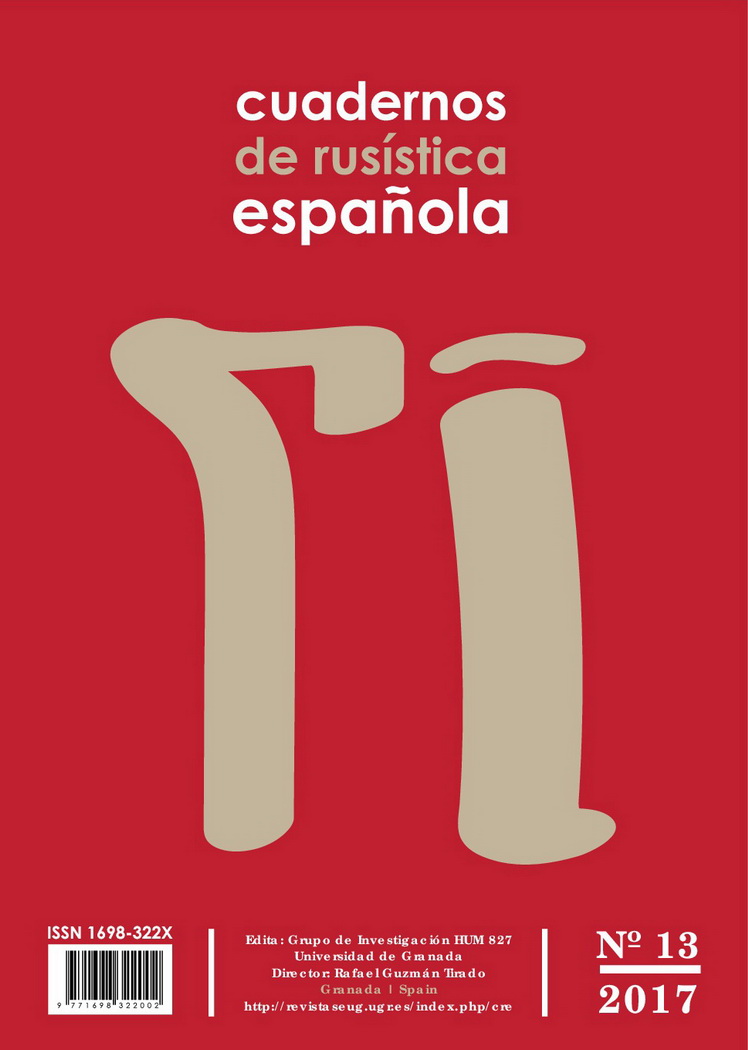Silence in the Structure of Aggressive Speech Behavior (Case Study of Day-To-Day Communication)
DOI:
https://doi.org/10.30827/cre.v13i0.6388Palabras clave:
Day-to-day interaction, verbal behavior, verbal aggression, silence, intentional and non-intentional silenceResumen
Modern linguistics pays more than ever attention to the study of verbal aggression in various types of discourse. Day-to-day discourse is of special interest: on the one hand, communicants disclose their individual features in it; on the other hand, it most fully reflects the cultural and national specificity of communication. Speech aggression in day-to-day communication has a number of differences. So, both verbalized voiced elements and unvoiced ones - zero communication sign ‘silence’ - serve as a marker of this type of speech behavior. Silence is polyfunctional. This research studies silence as a speech act, as an elementary unit of speech interaction in an everyday life. The method of linguistic observation recorded dialogues where silence was included in the structure of speech behavior of participants. The analysis of functioning of this zero marker made it possible to identify the specifics of verbal aggression in day-to-day communication.
Descargas
Citas
BANDURA, A. (1983): “Psychological Mechanism of Aggression. In: Aggression: Theoretical and Empirical Reviews, Academic Press, New York, Vol. 1. pp. 1–40.
BARON, R. A., RICHARDSON, D. R. (1994): Human aggression. New York: Plenum.
BEATTY, M. J., MCCROSKEY J. C. (1997): “It's in Our Nature: Verbal Aggressiveness As Temperamental Expression. In: Communication Quarterly, Vol. 45, №4, p. 446 – 460.
DEM’YANKOV, V.Z. (1989): “Namereniye v interpretatsii i interpretatsiya namereniy v rechi”.
CHOMSKY, N. (1959): “A review of Skinner's verbal behavior”, Language, 35, pp. 26-58.
[Intention in Interpretation and Interpretation of Intention in Speech]. In: Tekst: Struktura i analiz. [Text: Structure and Analysis], Institute of Linguistics of the Academy of Sciences of the USSR, Moscow.
DRIDZE, T.M. (1980): Yazyk i sotsialnaya psikhologiya. [Language and Social Psychology]. Vysshaya Shkola [Higher School]. Moscow.
INFANTE, D.A. (1995): “Teaching Students to Understand and Control Verbal Aggression. In: Communication Education, January, Vol. 44, №1, pp. 51–62.
INFANTE, D.A., RANCER A.S. (1996): “Argumentativeness and Verbal Aggression: A Review of Recent Theory and Research. In: Communication Yearbook, №19, pp. 319–351.
JAKOBSON, R. (1960): “Linguistics and poetics”. In: Sebeok, Thomas A. (Hg.). Style in Language. MA: MIT Press, Cambridge, pp. 350-377.
JAWORSKI, A. (1993): The Power of Silence: Social and Pragmatic Perspectives. Newbury Park, CA: Sage.
JENSEN, J.V. (1976): “Communicative Functions of Silence In: De Vito J.A. Communication: Concepts and Processes, Englewood Cliffs: Prentice Hall, pp. 124–132.
KLYUEV, E.V. (2002): Rechevaya kommunikatsia. [Verbal Communication]. RIPOL KLASSIK. Moscow.
KOPYLOVA, T. R. (2016): “Silence”. In: Theory of Communication: from A to Z, Udmurt State University, Izhevsk.
LEIGLAND, S. (2007): Fifty years later: Comments on the further development of a science of verbal behavior. In: The Behavior Analyst Today, 8, pp. 336-346.
LEONTYEV, A.A. (1999): Psikhologiya obshcheniya. [Psychology of Communication]. Smysl, Moscow.
MAKAROV, M.L. (2003): Osnovy teorii diskursa. [Foundations of Discourse Theory]. Publishing House ‘Gnozis’. Moscow.
NORMAND, M. (2001): “Verbal Behavior: History and Future". In: The Behavior Analyst Today, 3 (1), pp. 41–55.
POCHEPTSOV, G.G. (2001): Teoriya kommunikatsii. [Communication Theory]. Publishing House ‘Refl-Book’: Vakler. Moscow.
SHVEITSER, A.D. (1990) Sociolingvistika. [Sociolinguistics]. In: Lingvisticheskiy entsiklopedicheskiy slovar’. [Linguistic Encyclopedic Dictionary], Soviet Encyclopedia, Moscow.
SKINNER, B. (1957): Verbal Behavior. Acton, MA: Copley Publishing Group.
TANNEN, D. (1990): “Silence as Conflict Management in Fiction and Drama: Pinter's Betrayal and a Short Story, “Great Wits” In: Conflict Talk, Cambridge University Press, Cambridge; New York, pp. 260–280.
VINOKUR, T.G. (1993): Govoryashchiy i slushayushchiy. Varianty rechevogo povedeniya. [The Speaker and the Listener. Variants if Speech Behaviour]. Nauka. Moscow.
VORONTSOVA, T.A. (2006): Rechevaya agressiya: vtorzheniye v kommunikativnoe prostranstvo. [Speech Aggression: Penetration of Communicative Space]. Publishing House ‘Udmurtskiy Universitet’ [Udmurt University]. Izhevsk.
VORONTSOVA, T.A. (2009): “Kommunikativnoye prostranstvo v lingvopragmaticheskoy paradigm” [Communicative Space in Linguopragmatic Paradigm], Vestnik Udmurtskogo Universiteta, Seriya Istoriya i filologiy, 1 [Newsletter of Udmurt University, Series ‘History and Philology], pp. 11-17.
VORONTSOVA, T.A. (2012): “Rechevaya agressiya, tolerantnost’, vezhlivost’”. [Speech Aggression, Tolerance, Politeness]. In: Yazyk SMI i politika [Mass Media Language and Politics (Multi-Authored Monograph)], Publishing House of Moscow University; Journalism Department of Lomonosov Moscow State University, Moscow.
WOLFSON, N. (1988): “The Bulge: A theory of speech behaviour and social distance”. In: J. Fine ed., Second Language Discourse: A Textbook of Current Research, Norwood, N.J.: Ablex, pp. 21-38.












